Glacier recession and water (in)security
This article explores problems associated with mountain glacier recession, and how geographers can help to solve those problems
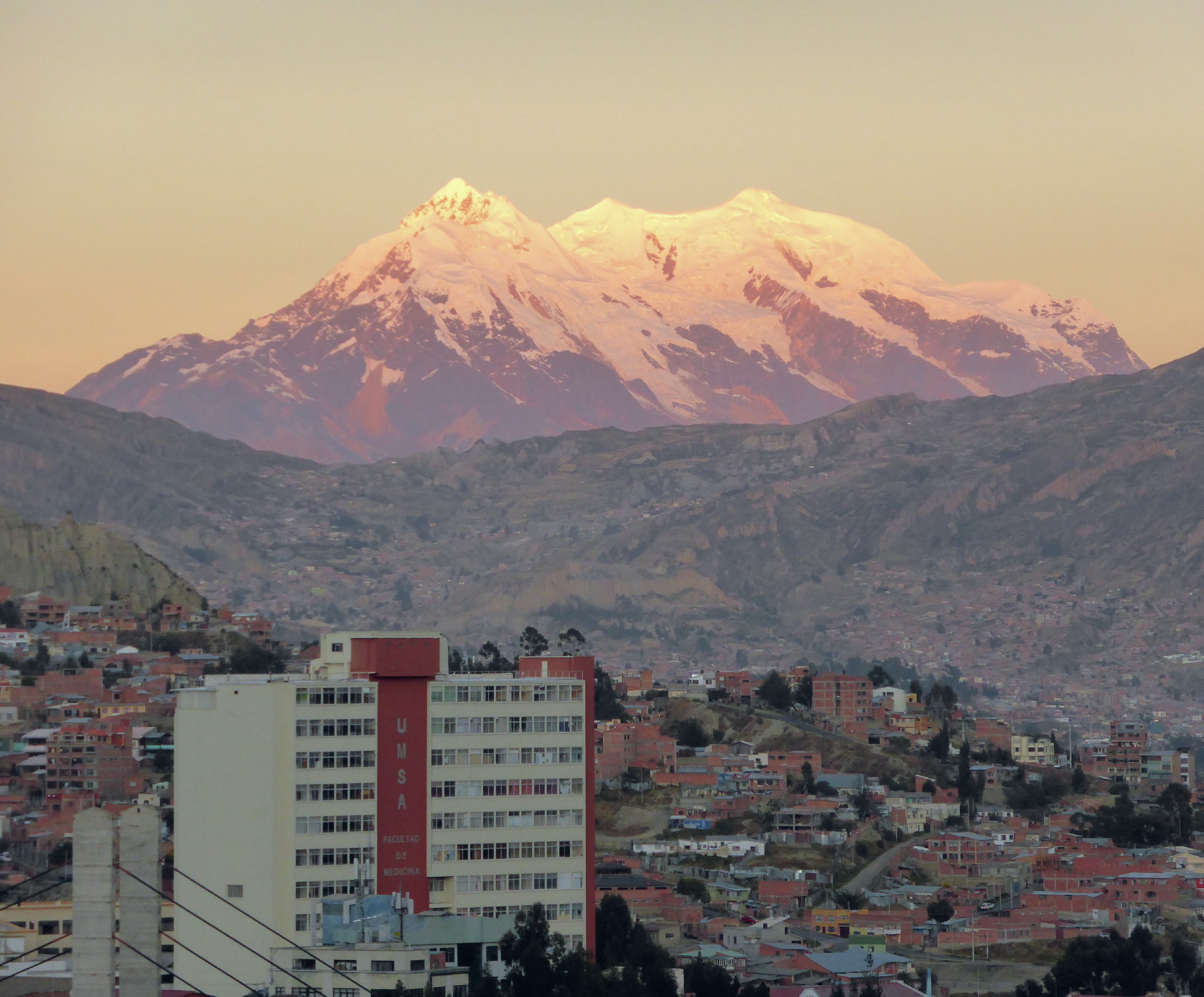
Most glaciers around the world are shrinking, either by receding, thinning, or both. Glaciers shrink when they lose more ice through ablation processes, such as melting or the calving of icebergs, than is replaced through the accumulation of snow. Glaciologists conceptualise the inputs and outputs to the glacier system as ‘mass balance’ — rather like a bank balance, except the currency is ice and water rather than money.
In today’s warming climate, most glaciers experience enhanced melt rates and so have a negative mass balance. Indeed, glaciers are often described as ‘sentinels’ of climate change because they are so responsive to changes in temperature and precipitation. But apart from providing a powerful symbol of climate change, why does it matter if glaciers shrink or disappear?
The importance of glaciers for water security
Arguably the most important consequence of glacier shrinkage for people is the impact on water resources. In the UK, we derive most of our water from groundwater or from surface reservoirs fed by rivers and rainfall. But in many parts of the world, particularly in mountainous regions such as the Karakoram-Himalaya and the Andes, glaciers are the main store and water is supplied to downstream areas by glacier melt. This water is used for drinking, irrigation and hydropower generation.
It is estimated that around 1.9 billion people worldwide live in areas where water is supplied by glacier and snow melt. Roughly 800 million of those people live in Asia where the glaciers of the Himalaya and adjacent mountain ranges are crucial for the supply of water, especially in more arid areas and in areas of seasonal rainfall. Consequently, if glaciers were to disappear completely, or become too small to sustain sufficient meltwater supply, then the lives and livelihoods of those people would be at risk.
It’s worth noting that some glacier melt is entirely normal and desirable. A glacier with continued input of snowfall, but no melt, would have a sustained positive mass balance causing continued growth and advance. People living in mountainous regions need glaciers to melt a little in order to provide water. Typically, glacier melt is strongly seasonal. For example, a glacier in the Swiss Alps will melt more in the summer than it will in the winter, and this gives a distinct summer melt season. But a big question is how long glaciers will survive in a warming climate, and hence how long they will continue to supply water to people who need it.
Peak water
One way of thinking about this problem is through the concept of ‘peak water’ (Figure 1). Figure 1 has an upper panel (Figure 1a) that shows runoff from a river basin that is fed by glacial meltwater, and how this evolves over time. The lower panel (Figure 1b) shows a hypothetical situation where temperature is initially stable, but then increases over time.
Stability
In the first time slice, T1, the glacier is in balance under a stable climate. That is to say that the inputs and outputs to the glacier system are equal; there’s as much snowfall as there is melting and so the glacier mass balance is zero. At this point, the glacier is neither advancing nor receding, neither thickening nor thinning, and is able to provide a reliable supply of meltwater to people downstream without losing mass in the long term.
Meltwater
In the second time slice, T2, Figure 1b indicates that temperature is increasing, which will cause the glacier mass balance to become negative as more melting takes place. There are two curves illustrated in Figure 1a: for the total annual meltwater runoff from the glacier, and for the melt season runoff. In both cases, the warming results in an initial increase in meltwater runoff volumes up to a tipping point known as peak water. This is a period of enhanced meltwater supply to downstream regions. After peak water, there is a decline in runoff as temperature continues to increase. This is because glaciers become too small to supply the same amount of water despite the enhanced melt rates.
A return to stability
In the third time slice, T3, annual meltwater runoff has returned to pre-warming levels equivalent to the situation in T1. If a glacier still exists at this time, then runoff will continue to be supplied by glacier melt, but otherwise some runoff is provided by snow melt and rainfall. Melt season runoff at T3 is lower than at T1 because there is much less glacier ice to supply meltwater, which would otherwise dominate runoff supply at this time of year. The glacier store is much diminished at T3.
In essence, the peak water concept tells us that there will be times of plentiful meltwater followed by a long-term decline in meltwater supply, with very significant implications for people who depend upon it. But the situation is likely to be very complex over space and time. The available evidence indicates that some mountain communities have already passed peak water, while others don’t seem to be there yet. But in any case, populations in glacierised regions of the world are moving from having a known, reliable, secure water supply to an uncertain, unreliable, insecure water supply. The question for many people will be: when will we enter into a time of water insecurity, and what can we do about it?
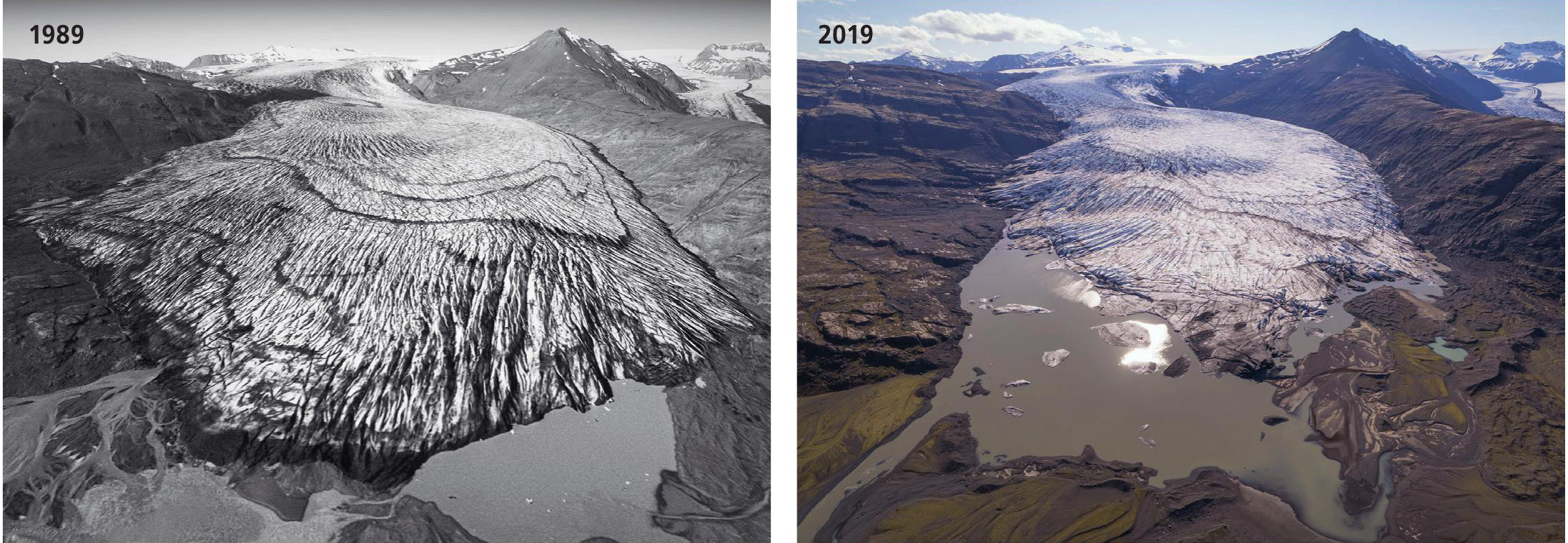
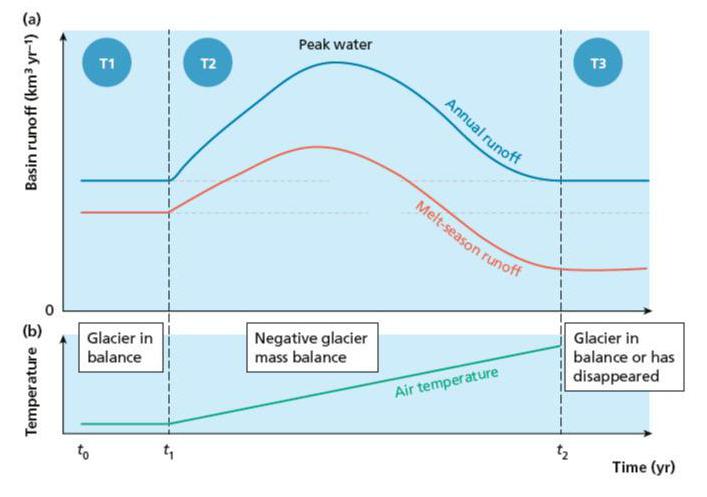
Case study: The Andes
Let’s take an example of a region affected by glacier demise: the Peruvian and Bolivian Andes (Figure 2). To the east of the Andes is the Amazon Basin, with plentiful rainfall. However, the western side of the divide, stretching down to the Pacific Ocean, is much drier. Crucially, this region experiences a strongly seasonal precipitation pattern with a distinct wet season (from November to April) and dry season (from May to October).
During the dry season, glaciers provide an important component of river runoff to mountain communities and to major population centres. La Paz, for example, is home to ~2.3 million people with roughly 15% of its annual water supply coming from glacier melt, although this proportion almost doubles during the dry season). However, Bolivian glaciers have shrunk by more than 40% since the mid-1980s, which raises major concerns about the sustainability of water supply in the region.
Monitoring of runoff from the Zongo glacier, which is one of the glaciers that supplies meltwater to La Paz, indicates that peak water has not yet been reached, but unfortunately this represents one of the very few wellmonitored glaciers in the region. The smaller Chacaltaya glacier, located just 8 km from the Zongo, disappeared completely in 2009.
Glacial lakes: a possible solution?
Geography is not just about measuring and logging these sorts of problems; we need also to think about solutions. If glaciers are going to continue to shrink then alternative water supplies must be considered. One possibility is the use of lakes that are commonly left behind as glaciers recede. Glaciers are very effective at carving out basins beneath themselves and transferring sediments to their termini where they deposit those sediments as moraines. As a glacier recedes, meltwater will collect in the basin in front of the glacier, dammed behind the terminal moraine. This natural reservoir can be used to supply water downstream, and also to generate hydropower.
Glacial lakes are not a magic bullet to the problem of lost glacier water stores. The presence of lakes upstream of population centres or infrastructure represents a significant risk of glacial lake outburst floods (GLOFs). The moraines that dam glacial lakes are composed of loose sediment and are relatively weak structures. Many of these glacial lakes are found in steep, mountainous terrain that is often tectonically active. This raises the chances of a landslide, avalanche or large iceberg calving event impacting the lake, causing a wave to overtop or destroy the moraine dam, and continue downstream.
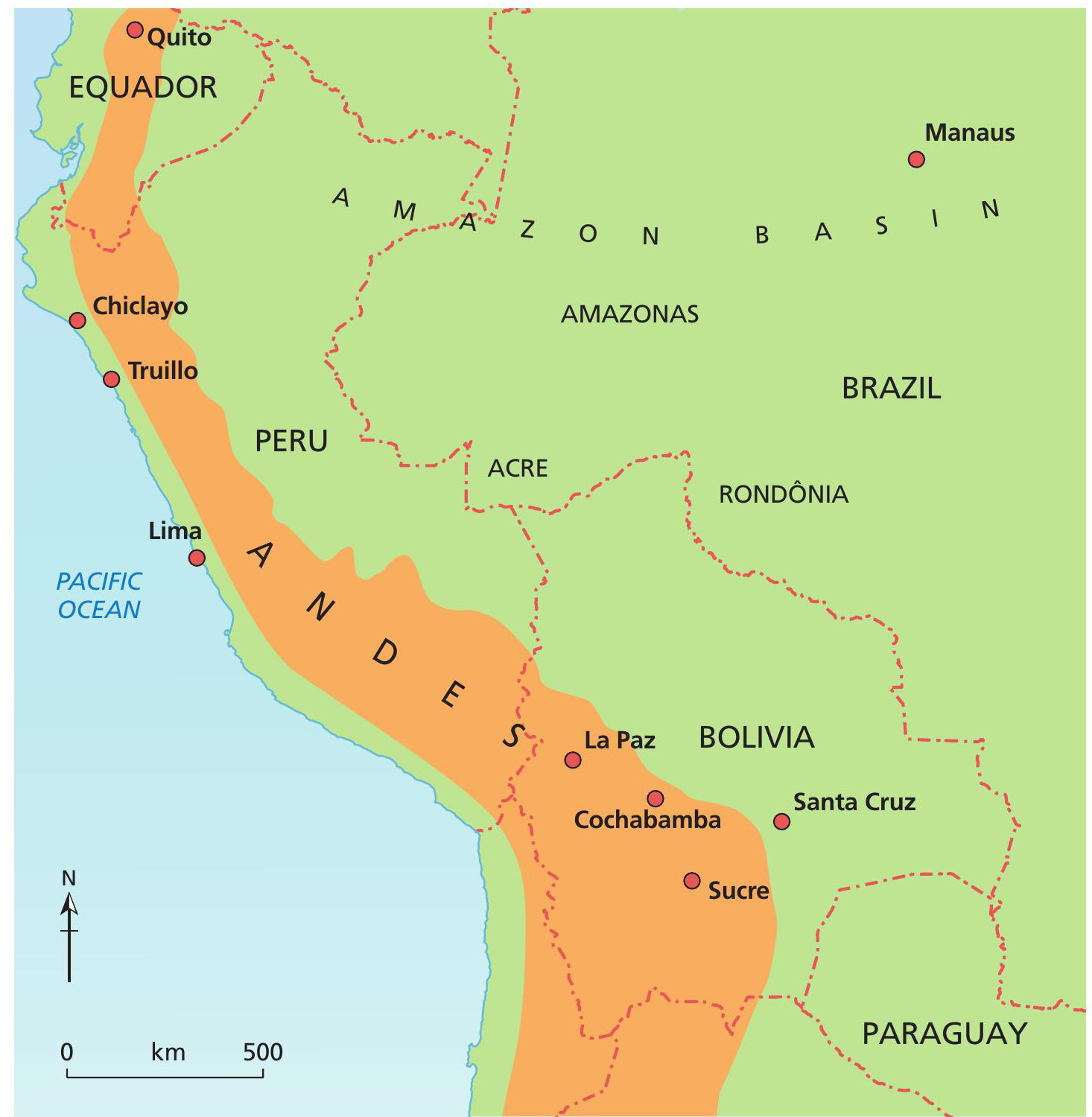
Laguna Palcacocha
One of the most infamous examples of a GLOF occurred in 1941 at Laguna Palcacocha in the Cordillera Blanca, Peru. For reasons that are still unclear, the moraine dam was breached, and a sediment-laden flood wave travelled around 20 km down-valley where it hit the city of Huaraz. It is estimated that 1,800 people lost their lives, although some estimates are higher still.
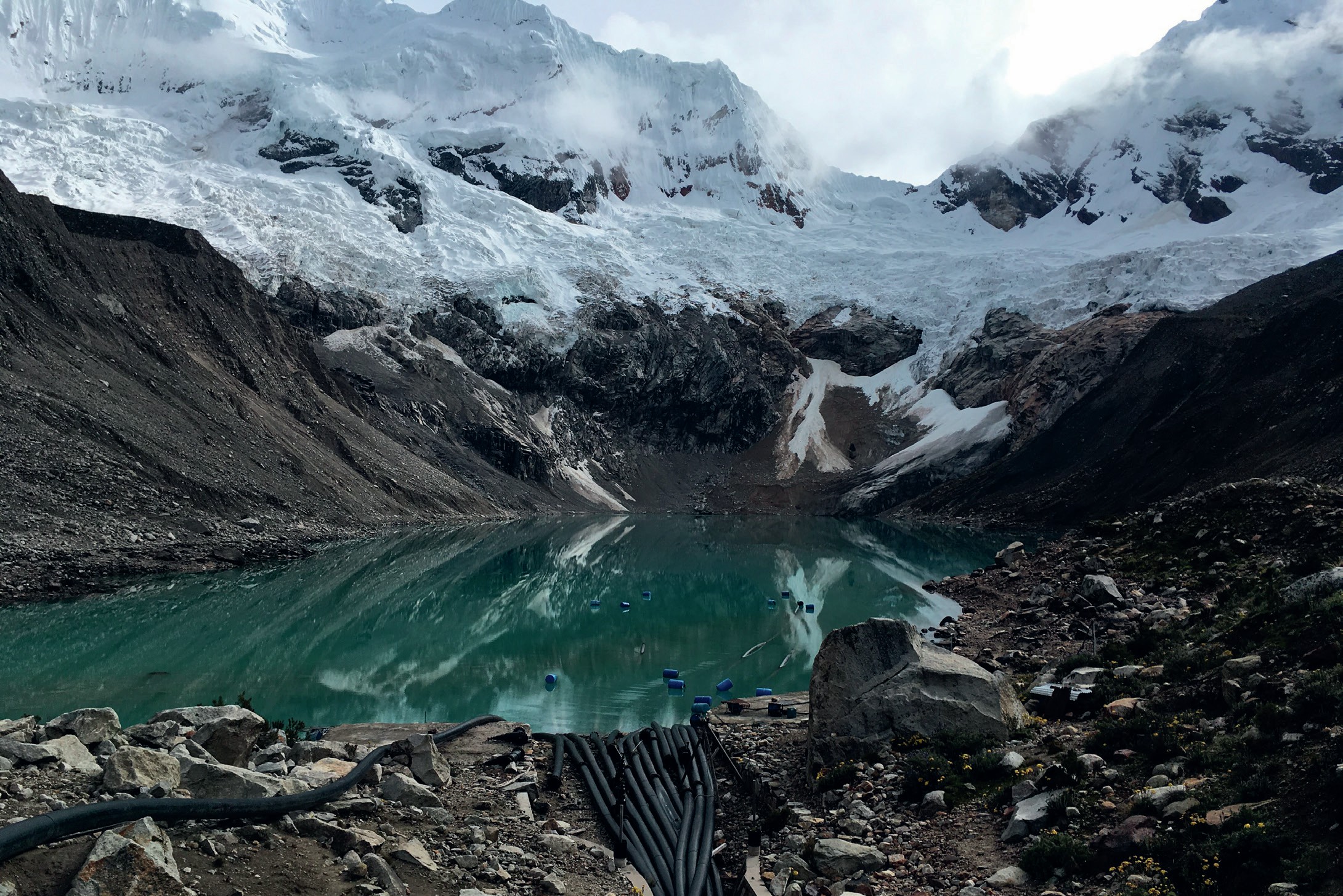
Huaraz derives ~19% of its water supply from glaciers, so on the one hand needs Palcacocha as a water supply, but on the other needs the lake volume to be limited in order to reduce GLOF risk. In the 1970s, the Peruvian government installed engineered dams to reinforce the terminal moraine that impounds the lake, and outlet syphons to control the water volume. Palcacocha is also monitored very closely by scientists. But the glacier has continued to recede and the lake has expanded, so the problem has not gone away. Nonetheless, carefully selected lakes may be helpful in storing water to sustain communities beyond peak water.
We have more work to do
There is still much work to do in order to find solutions for sustainable water supply in glacierised regions of the world. This article has focused on water quantity, but glacial water quality is far less understood, and equally as important. Glacially crushed sediments are very reactive, meaning that they can alter the chemistry and pH of meltwaters, in some cases rendering them dangerous to drink.
Furthermore, there are significant social, cultural and political implications associated with glacier loss and an insecure water supply. For example, glaciers are culturally important to some mountain communities and their loss has a huge impact on identity; there are conflicts between hydropower companies and local communities over who should control water supplies.
The coming years and decades will see continued glacier loss in mountain regions. Geographers have a crucial role to play in addressing the issue of water insecurity now and in the future.
RESOURCES
Amos, J. (19 December 2019) ‘Climate change: 1.9 billion people rely on natural ‘water towers’, BBC News: www.tinyurl.com/y3nffuu4.
Cook, S. (20 October 2016) ‘Bolivia’s fastmelting glaciers are leaving behind lakes that could cause catastrophic floods’, The Conversation: www.tinyurl.com/y2vz67pv.
Jorio, L. (30 September 2019) ‘As glaciers shrink are the Alps more dangerous?’, SWI: www.tinyurl.com/y2f2dlpa.
Jorio, L. (20 November 2019) ‘Melting Swiss glaciers to fuel conflicts over water’, SWI: www.tinyurl.com/y2vrwuo6.
Moens, J. (30 January 2020) ‘Andes meltdown: new insights into rapidly retreating glaciers’, Yale Environment 360: www.tinyurl.com/y2sgrgvx.
Morelle, R. (25 October 2019) ‘Images reveal Iceland’s glacier melt, BBC News: www.tinyurl.com/y5eukhek.
(10 October 2019) ‘Shrinking glaciers: Mont Blanc from the air, 100 years on’, Guardian: www.tinyurl.com/y45r4xwg.
Questions for discussion
1 How might people in wealthier countries, such as in the Swiss Alps, be affected differently by glacier shrinkage compared to people in poorer countries, such as in the Bolivian Andes or Nepalese Himalaya?
2 What factors could affect how quickly a glacier-fed drainage basin will reach peak water?
KEY POINTS
■ Glaciers in most parts of the world are shrinking due to climate warming.
■ Meltwater runoff from glaciers initially increases in a warming climate, but a tipping point is reached beyond which glaciers become too small to sustain river flows.
■ People dependent on glaciers for water may experience water shortages as glaciers shrink or disappear.
■ Other stores of water need to be found to ensure a secure water supply.
GeographyReviewExtras
For a quiz on this topic, go to: www.hoddereducation.co.uk/geographyreviewextras





